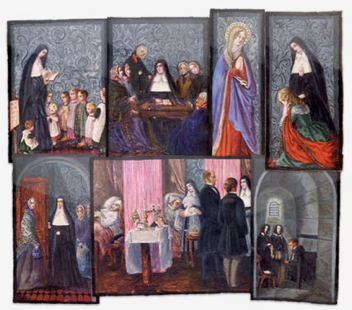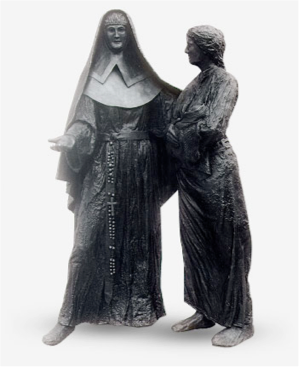The Founder
Much is written about why Catherine, at the age of 53, founded a religious order. Here it is enough to say that she recognised it as God’s way of enabling her and the several women who had joined her, to continue their critical work among the poorest people of Dublin.


Mercy International Center (Formerly House of Mercy, Baggot St, Dublin)


Images from the Objects of the Congregation by Sr. Clare Augustine Moore
House of Mercy
That work began systematically in 1827 with the opening of the House of Mercy which Catherine had built and equipped with her own inheritance. Dedicated to Mary the Mother of Mercy and given over to Works of Mercy, it was a centre to which people came for refuge and from which Catherine and her friends went daily into the streets and hovels caring for the sick and dispossessed.
Catherine’s Lifetime Concerns
In a real way, the House of Mercy witnessed to Catherine’s life-time concerns. Influenced by her father, a man of faith and refined social conscience, from early childhood she had demonstrated deep sensitivity to people who suffered the extremes of poverty and all her adult life she had cared for those who were destitute, denied education, meaningful employment or any other opportunity to achieve a fair quality of life.


Statue of Catherine McAuley by Michael Burke, commissioned for the opening of Mercy International Center in 1994.
Social Reformers
There is a sense in which Catherine and the women she inspired to join her could be regarded as social reformers. In a society marred by socio-political forces that protected the privileged and oppressed the poor, the majority of whom were Catholics, they spent themselves and their resources trying to confront the causes of chronic poverty and to alleviate its demeaning effects such as ignorance, ill health and homelessness. And while their outreach was to all, they had a special care for young women and girls vulnerable to exploitation.
Women of Gospel Faith
However, before they were social reformers, these Sisters of Mercy were women of Gospel faith. They believed that God, in whose image every person is created, is the source of human dignity. They understood that God, self-revealing in Jesus, is full of compassion and that no-one is unworthy of God’s love. They were convinced that if God’s wisdom and justice guides the leaders of a society, no person need be excluded from life-giving opportunities.
Catherine exemplified such faith. It was at the heart of all the ways in which she carried out the corporal and spiritual works of mercy (Isaiah 58:6 -10; Matthew 25:34 – 40). And it was her whole-hearted commitment to serving those who were longing for God’s Mercy that encouraged other women to share in her life’s work.
